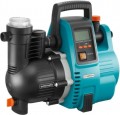Maximum performance
The maximum volume of water that the device can pump in a certain amount of time. It is one of the key specs of any pump because characterizes the volume of water with which the device can work. At the same time, it does not always make sense to pursue maximum performance — after all, it significantly affects the dimensions and weight of the unit.
Some formulas allow you to derive optimal performance values for different situations. So, if the pump is designed to supply water to water intake points, its minimum required performance should not be lower than the highest total flow rate; if desired, a margin of 20-30% can be added to this value. And for sewer models (see "Suitable for"), everything will depend on the volume of wastewater. More detailed recommendations for choosing a pump depending on performance can be found in special sources.
Maximum head
The maximum head generated by the pump. This parameter is most often indicated in meters, by the height of the water column that the unit can create — in other words, by the height to which it can supply water. You can estimate the pressure created by the pump using a simple formula: every 10 m of head corresponds to a pressure of 1 bar.
It is worth choosing a pump according to this parameter, taking into account the height to which it should supply water, as well as adjusting for losses and the need for pressure in the water supply. To do this, it is necessary to determine the difference in height between the water level and the highest point of water intake, add another 10 to 30 m to this figure (depending on the pressure that needs to be obtained in the water supply), and multiply the result by 1.1 — this will be the minimum pressure required.
Max. pressure
The highest pressure that the pump is capable of creating during operation. This parameter is directly related to the maximum head (see above); however, it is less obvious, and therefore, it is indicated rarely.
Maximum liquid temperature
The highest temperature of water at which the pump is capable of operating normally. Usually, in most models this parameter is 35-40 °C — at high temperatures it is difficult to ensure effective cooling of the engine and moving parts, and in fact, such conditions are rare.
Suction system
— Single-stage. Suction system with one impeller or similar element. Although such a design loses to a multistage one in terms of efficiency and power, at the same time, its characteristics are quite enough for most tasks; while single-stage pumps are simpler and cheaper. Due to all this, this option is used in most modern units.
— Multistage. This suction system consists of several impellers (or other similar parts that directly provide suction). Such pumps are significantly superior to single-stage ones, they provide powerful pressure and are less sensitive to impurities. At the same time, in fact, all these advantages are needed relatively rarely, and multistage systems are quite expensive. Because of this, they are used in a relatively small number of pumps — they are mainly powerful models designed for situations where one suction stage is not enough.
Noise level
The noise level produced by the pump during normal operation. For comparison, 50 decibels roughly corresponds to the noise in an office room, 60 dB to an average TV volume, 70 dB to a truck at a distance of about 8 m, 80 dB to traffic noise, and 90 dB to a scream. The lower the noise level, the more comfortable the use of the pump and the closer it can be placed to people. This parameter is especially important for models designed for indoor installation.

